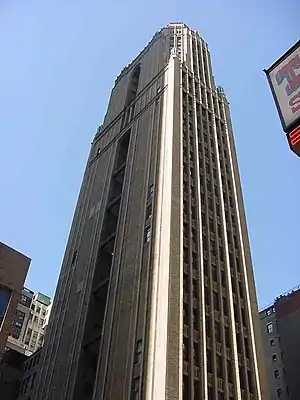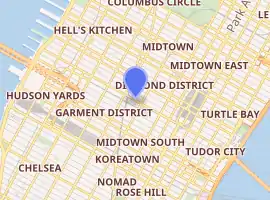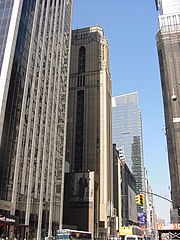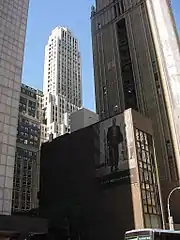Bush Tower
Bush Tower, also called the Bush Terminal International Exhibit Building and formerly as the Bush Terminal Sales Building, is a historic 30-story, 433-foot-tall (132 m) skyscraper located in Midtown Manhattan, New York City, just east of Times Square. The building occupies a plot at 130-132 West 42nd Street between Broadway and Sixth Avenue. It was built in 1916–1918 for Irving T. Bush's Bush Terminal Company, which operated Bush Terminal in the Sunset Park neighborhood of Brooklyn, New York City.
| Bush Tower | |
|---|---|
 | |

| |
| General information | |
| Status | Complete |
| Type | Commercial meeting space and display space Office |
| Location | 130-132 West 42nd Street New York, NY 10036 United States |
| Coordinates | 40°45′19″N 73°59′7″W |
| Construction started | 1916 |
| Completed | 1918 |
| Cost | $2 million in 1917[1] |
| Owner | Bush Terminal Company |
| Height | |
| Roof | 433 ft (132 m) |
| Technical details | |
| Floor count | 30 |
| Lifts/elevators | 4[1] |
| Design and construction | |
| Architect | Helmle and Corbett |
| Developer | Irving Bush |
New York City Landmark | |
| Designated | October 18, 1988[2] |
| Reference no. | 1561 |
| References | |
| [3] | |
Bush Tower was originally intended as a commercial display space and social space. Its design combined narrowness, height, and Neo-Gothic architecture. It was designated as a city landmark by the New York City Landmarks Preservation Commission in 1988.
Design
The building site measured only 50 feet (15 m) wide and 90 feet (27 m) long, but the structure erected on it rose over 433 feet (132 m) to its highest point.[4] The New York firm of Helmle and Corbett,[lower-alpha 1] and specifically architect Harvey Wiley Corbett, gave Bush Tower a Neo-Gothic appearance, in some ways similar in style to the Woolworth Building, completed in Lower Manhattan three years earlier. The architects remarked that they wanted to make the building "a model for the tall, narrow building in the center of a city block".[5]
Bush Tower influenced subsequent skyscraper design. Architect Raymond Hood credited the architects of this structure as an influence on his landmark American Radiator Building of 1924.[6] Written about in the Literary Digest[7] and Vanity Fair,[8] and by such critics as Lewis Mumford in Architecture,[9] and the tallest building in Midtown Manhattan when completed,[5][10] Bush Tower also signified the movement of the Manhattan business district to Midtown.[11]
Facade
The structure's 50-foot width, and its function as an office building, precluded the need for conventional skyscraper fenestration. The windows are concentrated on the north (42nd Street) and south facades. With the exception of a recessed mid-facade lightwell on the east facade, the east and west walls were left largely blank.[5] Instead, Trompe-l'œil brickwork creates vertical "ribs" with a false "shade" pattern to enhance the verticality. High pointed arched windows lighted the top double-height floor (the building is variously described as 29 or 30 floors). Even the water tower was hidden behind a mansard roof at the tower's peak.[11]
Interior
The tower's lowest three floors were planned for the comfort and convenience of buyers visiting New York. These floors were modeled after a traditional large metropolitan private club and housed the newly created International Buyers Club, which contained "that mysterious element called 'atmosphere' and 'social standing'",[1] yet representatives of any "reputable" firm could join for free. The company wrote these floors were also designed to be "welcoming of women members".[1]
The club offered conference rooms, multiple lounges (including "retiring rooms" for both ladies and gentlemen), offices, buffet service, and a large second-floor reading room staffed with trained librarians. The third-floor auditorium could host lectures, concerts, the viewing of manufacturers' own promotional motion pictures, or even "fashion parades" for "displaying gowns."[1]
These lowest floors featured extensive oak paneling, oriental carpets, and antique furniture; according to the company's published promotional literature, this "Old English" style gave one "the feeling of having entered a hundred-year-old tavern".[1]
The upper 27 stories held displays of manufacturers' goods, a concept explained as "the museum idea applied to commerce" by a writer for the Metropolitan Museum of Art's Bulletin.[5]
History
Development
Under Irving T. Bush, the Bush Terminal Co. created Bush Tower to bring buyers, manufacturers, and designers together.[5] As such, the company promoted a "vast centralized marketplace under one roof where complete lines of goods can be examined without loss of time".[1]
The Bush Terminal Company attempted a similar melding of commercial displays and social space at Bush House in London, built in three phases during the 1920s, but that concept was not fully carried through.[12]
Use
The Buyers' Club on the lower floors was quickly replaced by a bank in the early 1920s, then by the Old London Restaurant in 1931.[2]:8 After the Metropolitan Life Insurance Company foreclosed upon the tower in 1938[2]:8 the upper floors were converted for regular office usage.[13] An association of dress manufacturers moved into the tenth floor in 1939,[14] and six commercial and office tenants took space in 1941.[15] Herman's Stores, a sporting goods store, moved into the ground floor in early 1943,[16] and the American Red Cross and two other tenants took space later that year.[17] The tower was purchased and auctioned off by real estate investor Jacob Freidus in 1945.[13] It was subsequently bought by a syndicate co-headed by real estate developer Joseph Durst in 1951.[18]
By the early 1980s, the Times Square neighborhood and Bush Tower itself had deteriorated to the point where the owners considered demolishing the building. It was instead renovated, with heating and electrical systems replaced throughout.[10] The skyscraper was acquired in the 1980s by its present owners, by the Lebanese Dalloul family.[8] In 1988, the New York City Landmarks Preservation Commission designated Bush Tower as a city landmark.[2]:1[19][20]
In 2002, the owners publicized their plans for a new building immediately to the west of Bush Tower. In a design by the firm of Gruzen Samton, a 23-story glass tower would be separated by a 6-inch (15 cm) gap—necessitated by earthquake codes—but connected on every floor to double the original building's space.[8] In October 2006, Dubai-based developer Istithmar World purchased the properties at 136-140 West 42nd St., between Bush Tower and Istithmar-owned 6 Times Square (formerly the Knickerbocker Hotel).[21]
Gallery
 Looking west from 6th Avenue & 42nd Street.
Looking west from 6th Avenue & 42nd Street. Light well on side; building from NewsRadio show visible in distance
Light well on side; building from NewsRadio show visible in distance View of crown from 6th Avenue
View of crown from 6th Avenue View from Times Square; 1095 Avenue of the Americas looms behind it
View from Times Square; 1095 Avenue of the Americas looms behind it
References
Notes
- The firm also designed Bush House in London and the George Washington Masonic National Memorial in Alexandria, Virginia.
Citations
- Bush Terminal Company (1917). Bush Terminal International Exhibit Building & Buyers' Club. New York, Redfield-Kendrick-Odell Co.
- "Bush Tower" (PDF). New York City Landmarks Preservation Commission. October 18, 1988. Retrieved January 17, 2021.
- Bush Tower at Emporis
- http://skyscraperpage.com/cities/?buildingID=2249
- Stern, Robert A. M.; Gilmartin, Patrick; Mellins, Thomas (1987). New York 1930: Architecture and Urbanism Between the Two World Wars. New York: Rizzoli. p. 546. ISBN 978-0-8478-3096-1. OCLC 13860977.
- Hood, Raymond (November 19, 1924). "The American Radiator Building", American Architect 126, p. 472. Referenced in Landmarks Preservation Commission 1988, p. 7.
- "A tower that symbolizes a business philosophy." (July 10, 1920). Literary Digest, pp. 74–75
- Gray, Christopher (April 21, 2002). "Streetscapes/130 West 42nd Street; A Skinny Gothic Tower Is to Get a Modern Partner". The New York Times. ISSN 0362-4331. Retrieved November 26, 2018.
- Brock, H. I (February 20, 1927). "Manhattan's Canyons, Seen From Above; an Artist Finds Mystic Splendors That Skyline Gazers Never Behold From the Street". The New York Times. ISSN 0362-4331. Retrieved January 17, 2021.
- Depalma, Anthony (May 22, 1985). "About Real Estate; Renewal of West 42d St. Tower Is Nearly Completed". The New York Times. ISSN 0362-4331. Retrieved January 17, 2021.
- Nash, Eric Peter (2005). Manhattan skyscrapers. New York: Princeton Architectural Press, p. 27
- Saint, Andrew (1984). "Americans in London: Raymond Hood and the National Radiator Building." AA Files 7, 37-38
- "Freidus Is Buyer of Bush Building; Adds Midtown Skyscraper to His Investments". The New York Times. May 25, 1945. ISSN 0362-4331. Retrieved January 17, 2021.
- "Bush Tower Space Taken; Large Part of Tenth Floor Is Engaged by Association of Dress Manufacturers". The New York Times. July 8, 1939. ISSN 0362-4331. Retrieved January 17, 2021.
- "Bush Tower Gets Six New Tenants; One Lessee Takes the Whole 26th Floor -- Three Occupants Increase Their Space". The New York Times. March 28, 1941. ISSN 0362-4331. Retrieved January 17, 2021.
- "Philippine State Takes Floor Here; Commonwealth Leases Space in West 72d Street for General Headquarters". The New York Times. January 8, 1943. ISSN 0362-4331. Retrieved January 17, 2021.
- "Bush Tower Floors Leased by Red Cross; Two Other New Tenants Go to West 42d St. Building". The New York Times. September 23, 1943. ISSN 0362-4331. Retrieved January 17, 2021.
- "Deal Completed for Bush Tower; 30-story Building on 42d St. Acquired by a Syndicate-- Sale in Tunnel Area". The New York Times. July 18, 1951. ISSN 0362-4331. Retrieved January 17, 2021.
- Dunlap, David W. (October 19, 1988). "Panel Chooses A Former Hotel As a Landmark". The New York Times. ISSN 0362-4331. Retrieved January 17, 2021.
- New York City Landmarks Preservation Commission; Dolkart, Andrew S.; Postal, Matthew A. (2009). Postal, Matthew A. (ed.). Guide to New York City Landmarks (4th ed.). New York: John Wiley & Sons. p. 94. ISBN 978-0-470-28963-1.
- Elkies, Lauren (June 17, 2010). "Knickerbocker site deal closes at $180.5M". The Real Deal.
External links
| Wikimedia Commons has media related to Bush Tower. |
- Bush Terminal Company (1917). Bush Terminal International Exhibit Building & Buyers' Club. New York, Redfield-Kendrick-Odell Co. (Full-text.)
- The New York City Landmark Preservation Commission's 23-page report on Bush Tower and its designation as a landmark (1988)
- Citynoise article
- Many photos of Bush Tower, including historic views and exterior details, at nyc-architecture.com
- Bush Tower at skyscraperpage.com
- Historic image of Bush Tower from the New York Public Library Digital Gallery, showing how Bush Tower was one of the first skyscrapers in the Times Square/42nd St. area of Mid-Manhattan